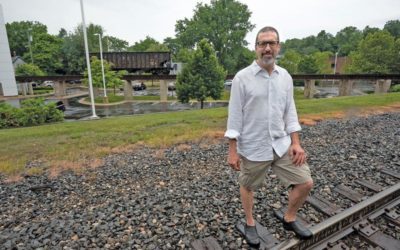Shorter print runs mean big cuts for Edwards Brothers Malloy.
A year after the two venerable local printers merged, the company announced that it will sell Edwards Brothers’ sixteen-acre State St. property and consolidate operations at Malloy’s plant on Jackson Rd. The news startled and excited the local real estate community. The company’s hundreds of employees were more than astounded; they were apprehensive.
There were fewer than a dozen layoffs as a result of the merger last year, but the consolidation will cost forty-seven additional jobs, with more to come. The cuts have shaken both managers and press operators. Of the combined firm’s 600 local employees, 150 have put in twenty-five years or more, and some are more than sixty years old. “For a lot of people this is home,” CEO John Edwards says. “I remember when they had kids and their kids had kids.”
Both Edwards and director of operations Bill Upton, former CEO of Malloy, say that at the time of the merger they had never anticipated such a drastic retrenchment. But orders for what had once been their primary business–offset printing runs of 3,000 or more copies–continue to decline.
“Our overall production of units, especially trade books, dropped 20 percent from 2010 to 2012, while the number of titles produced has exploded,” Upton says. “These are mostly new titles, many self published.” Instead of ordering thousands of books at a time, those buyers want just a handful of copies. And instead of offset presses, those super-short runs are printed on digital presses–essentially, giant photocopiers. “Between the two plants, in a typical month we produce 1,000 titles in offset, and 1,000 per day in digital,” Upton says.
After 120 years, the company’s managers are determined to survive the changes. “The fifth generation is close to coming into the business,” says Jim Edwards, John’s brother and CEO of the company’s publishing arm. “Our mission is unchanged; our resolve is unchanged. Our markets are constantly evolving and have been since the company was founded in 1893.”
One thing was clear: they didn’t need two large offset printing plants in Ann Arbor any more. “There are a lot of inefficiencies with two buildings,” John Edwards says. “For example, it costs a million dollars a year to heat and cool [the] State St. [plant].” Moving people and equipment to Malloy’s plant will raise costs there but between the efficiencies of operating in a single building and not using the offset presses, Upton estimates, they’ll save $600,000 a year on utilities alone.
But “it’s not just numbers,” Upton adds. “John knows everybody at State St., and I know everybody at Jackson Rd. It’s the folks affected that’s difficult. Unfortunately we couldn’t avoid the situation of the industry downturn. But we are taking steps to expand into the growing digital printing market, so I’m quite optimistic.”
“This decision was a big deal and not taken lightly or in a vacuum,” John Edwards says. “Dad told me, ‘You are a steward for the business. It’s not a cash machine for you. Make the business as viable as possible.’ We’ll move the best equipment to one building, and we’re investing heavily in digital printing customization, where we are well positioned already.
“I think the worst is behind us. As we sell the oldest presses we may well have more layoffs, though we hope to take it slow and lose people through natural attrition. The reaction of the employees, as the shock is wearing off, ranges from ‘What took you so long?’ to ‘I understand what you’re doing.’ But for some people it’s closer to home.”
Though Edwards will still have his job, leaving State St. for the former Malloy plant will be wrenching. He has spent all his working life, except for four years, in the place where his grandfather, father, and uncle once presided.
“After Dad died seven years ago,” he says, “I couldn’t bring myself to use his office for four years. There are ghosts in the hallways.”



